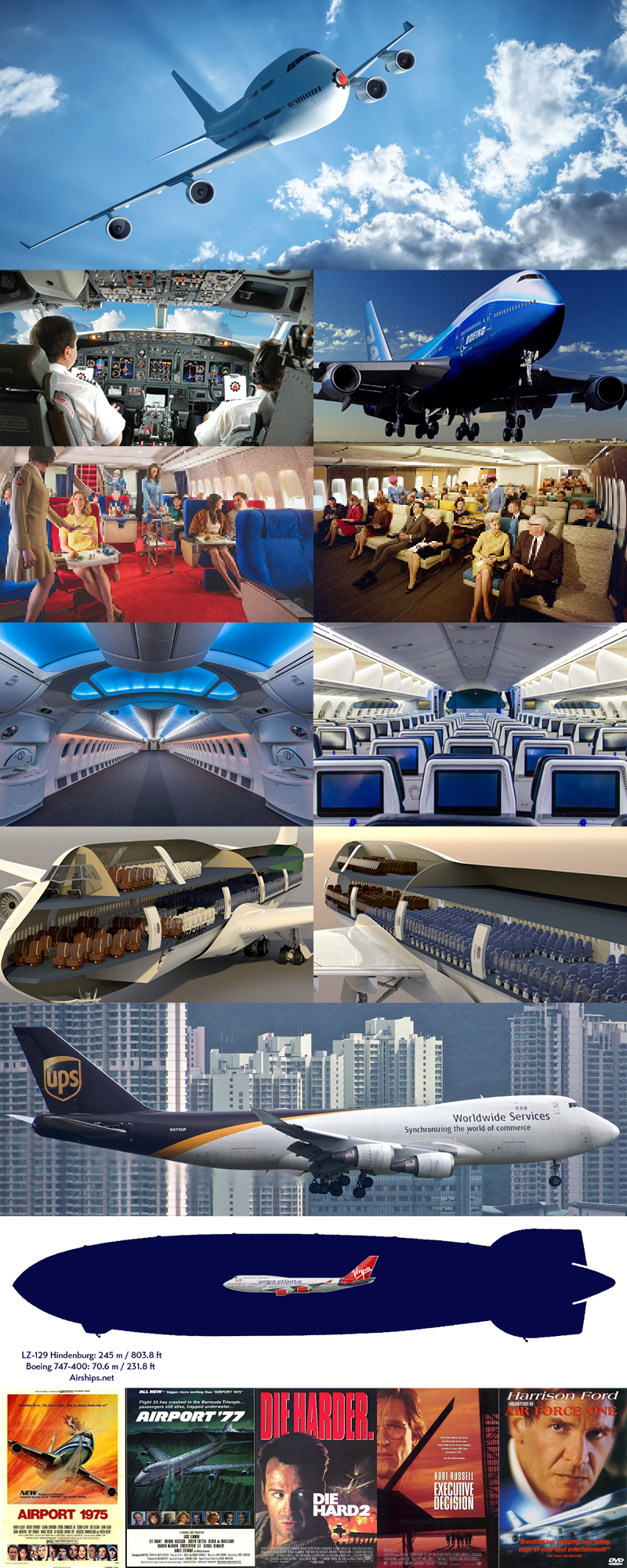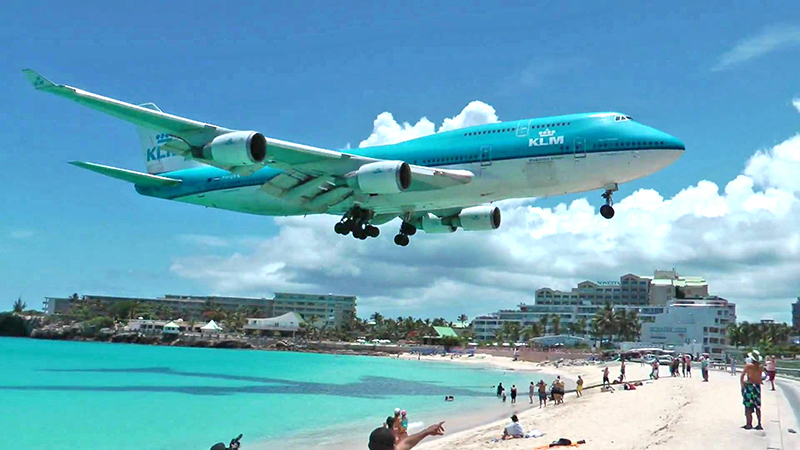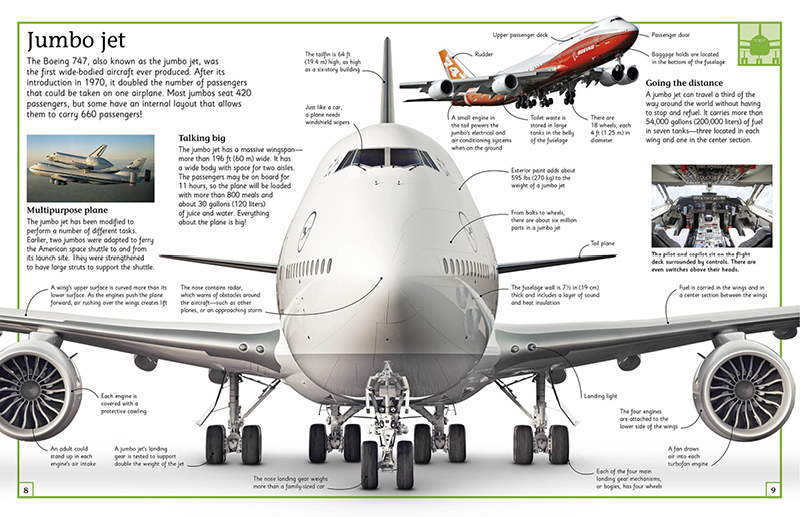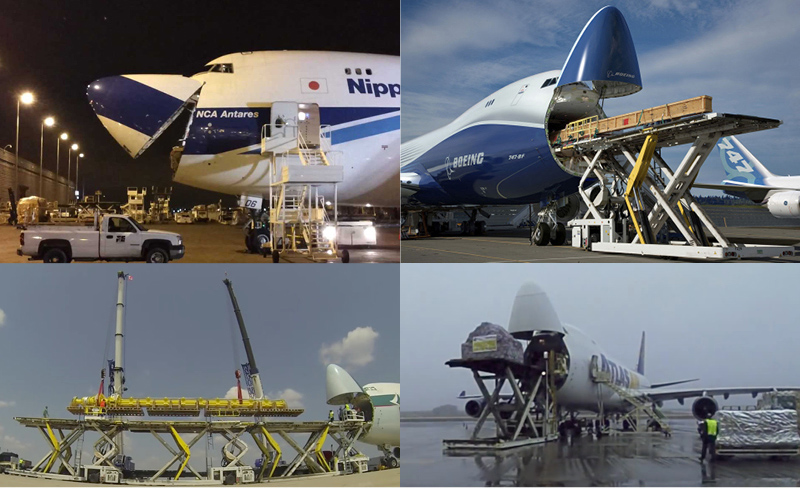Marvel “ous”

(Top) One of the proposed 747 designs in the Kowalski fleet. We’ve named this one Rudolph. (row 2) Yes, you do need to be a rocket scientist to fly one of these babies. (row 3) Artist depiction of the comfortable and roomy passenger seating. (row 4) The actual passenger area without seats and with seats. (row 5) The passenger seating areas. (row 6) This cargo version landing in Hong Kong. (row 7) The Hindenburg vs the Boeing 747-400. (row 8) The 747 has starred in more movies than Harrison Ford, Bruce Willis, Kurt Russell, Jack Lemmon, George Kennedy and Efrem Zimbalist, Jr combined.
Ever since I can remember, I’ve been fascinated by airplanes. I love watching them take off, and land, and glide in the air with ridiculous ease – giant, massive structures just floating along. I can remember as a kid going out to the airport and crouching down when the planes flew over the car, thinking they were almost close enough to touch. As our heat treating aerospace business has grown, and now complimented with our latest NADCAP heat treating accreditation, I just love it when customers call with their aerospace PIA (Pain in the @%$ Jobs)! My guys jump at the chance to solve customer’s problems, and deliver consistent, “reliable” (ever think how important that is for aircraft) parts, that end up in components, and then on aircraft. Seeing planes in the air still makes me smile, because I know part of KHT is also riding along. 50 years ago this month, a marvel was introduced to the world, that changed the aviation landscape – the introduction of the Boeing 747. Bigger and better than anything at its time, it took the industry by storm, but more importantly, has been a global workhorse for airlines and a delight for passengers. I found a fun article in Smithsonian magazine, and also pulled some facts and history from Wikipedia to share. Hats off to Boeing, and all the designers, engineers, pilots, employees and maintenance crews who built over 1,500 planes, and have kept her flying all these years – Enjoy!
- The Boeing 747 is an American wide-body commercial jet airliner and cargo aircraft, often referred to by its original nickname, “Jumbo Jet”. Its distinctive hump upper deck along the forward part of the aircraft has made it one of the most recognizable aircraft and the first wide-body airplane produced.
- Rolled from the hangar in Everett, Washington 50 years ago this weekend, onlookers were stunned.The aircraft before them was more than double the size and weight of any existing airliner. Its instant fame came with its size – two aisles, two floors, four massive engines and a six-story tail fin, allowing millions of passengers to travel the globe, it changed aviation forever.
- The four-engine 747 uses a double-deck configuration for part of its length and is available in passenger, freighter and other versions. Boeing designed the 747’s hump-like upper deck to serve as a first–class lounge or extra seating, and to allow the aircraft to be easily converted to a cargo carrier by removing seats and installing a front cargo door. Boeing expected supersonic airliners—the development of which was announced in the early 1960s—to render the 747 and other subsonic airliners obsolete, while the demand for subsonic cargo aircraft would remain robust well into the future. Though the 747 was expected to become obsolete after 400 were sold, it exceeded critics’ expectations with production surpassing expectations. By July 2018, 1,546 aircraft had been built, with 22 of the 747-8 variants remaining on order.
- The 747-400, the most common variant in service, has a high-subsonic cruise speed of Mach 0.85–0.855 (up to 570 mph or 920 km/h) with an intercontinental range of 7,260 nautical miles (8,350 statute miles or 13,450 km).[14] The 747-400 can accommodate 416 passengers in a typical three-class layout, 524 passengers in a typical two-class layout, or 660 passengers in a high–density one-class configuration
- In 1963, the United States Air Force started a series of study projects on a very large strategic transport aircraft. Although the C-141 Starlifter was being introduced, they believed that a much larger and more capable aircraft was needed, especially the capability to carry outsized cargo that would not fit in any existing aircraft. These studies led to initial requirements for the CX-Heavy Logistics System (CX-HLS) in March 1964 for an aircraft with a load capacity of 180,000 pounds (81,600 kg) and a speed of Mach 0.75 (500 mph or 800 km/h), and an unrefueled range of 5,000 nautical miles (9,300 km) with a payload of 115,000 pounds.
- Featuring only four engines, the design also required new engine designs with greatly increased power and better fuel economy. In May 1964, airframe proposals arrived from Boeing, Douglas, General Dynamics, Lockheed, and Martin Marietta; engine proposals were submitted by General Electric, Curtiss-Wright, and Pratt & Whitney. After review, Boeing, Douglas, and Lockheed were given additional study contracts for the airframe, along with General Electric and Pratt & Whitney for the engines.
- All three of the airframe proposals shared a number of features. As the CX-HLS needed to be able to be loaded from the front, a door had to be included where the cockpit usually was. All of the companies solved this problem by moving the cockpit above the cargo area; Douglas had a small “pod” just forward and above the wing, Lockheed used a long “spine” running the length of the aircraft with the wing spar passing through it, while Boeing blended the two, with a longer pod that ran from just behind the nose to just behind the wing. In 1965 Lockheed’s aircraft design and General Electric’s engine design were selected for the new C-5 Galaxy transport, which was the largest military aircraft in the world at the time. The nose door and raised cockpit concepts would be carried over to the design of the 747.
- The 747 was conceived while air travel was increasing in the 1960s. The era of commercial jet transportation, led by the enormous popularity of the Boeing 707 and Douglas DC-8, had revolutionized long-distance travel. Boeing was asked by Juan Trippe, president of Pan American World Airways (Pan Am), one of their most important airline customers, to build a passenger aircraft more than twice the size of the 707. During this time, airport congestion, worsened by increasing numbers of passengers carried on relatively small aircraft, became a problem that Trippe thought could be addressed by a larger new aircraft.
- In April 1966, Pan Am ordered 25 747-100 aircraft for US $525 million. During the ceremonial 747 contract-signing banquet in Seattle on Boeing’s 50th Anniversary, Juan Trippe predicted that the 747 would be “… a great weapon for peace, competing with intercontinental missiles for mankind’s destiny”. As the first customer, and because of its early involvement before placing a formal order, Pan Am was able to influence the design and development of the 747 to an extent unmatched by a single airline before or since.
- The original design included a full-length double-deck fuselage with eight-across seating and two aisles on the lower deck and seven-across seating and two aisles on the upper deck. Concern over safety, evacuation routes and limited cargo-carrying capability caused this idea to be scrapped in early 1966 in favor of a wider single deck design. The cockpit was, therefore, placed on a shortened upper deck so that a freight-loading door could be included in the nose cone; this design feature produced the 747’s distinctive “bulge”. In the early models it was not clear what to do with the small space in the pod behind the cockpit, so it was initially specified as a “lounge” area with no permanent seating
- One of the principal technologies that enabled an aircraft as large as the 747 to be drawn up was the high-bypass turbofan engine by Pratt & Whiney. The engine technology was thought to be capable of delivering double the power of the earlier turbojets while consuming a third less fuel. General Electric had pioneered the concept but was committed to developing the engine for the C-5 Galaxy and did not enter the commercial market until later
- Boeing agreed to deliver the first 747 to Pan Am by the end of 1969. The delivery date left 28 months to design the aircraft, which was two-thirds of the normal time. The schedule was so fast-paced that the people who worked on it were given the nickname “The Incredibles”. Developing the aircraft was such a technical and financial challenge that management was said to have “bet the company” when it started the project.
- As Boeing did not have a plant large enough to assemble the giant airliner, they chose to build a new plant. The company considered locations in about 50 cities, and eventually decided to build the new plant some 30 miles north of Seattle on a site adjoining a military base at Paine Field near Everett, Washington.
- To level the site, more than four million cubic yards (talk about a PIA Job!) of earth had to be moved. Time was so short that the 747’s full-scale mock-up was built before the factory roof above it was finished. The plant is the largest building by volume ever built, and has been substantially expanded several times to permit construction of other models of Boeing wide-body commercial jets.
- The prototype 747 was first displayed to the public on September 30, 1968. Before the first 747 was fully assembled, testing began on many components and systems. One important test involved the evacuation of 560 volunteers from a cabin mock-up via the aircraft’s emergency chutes. The first full-scale evacuation took two and a half minutes instead of the maximum of 90 seconds mandated by the Federal Aviation Administration (FAA), and several volunteers were injured. Subsequent test evacuations achieved the 90-second goal but caused more injuries. Most problematic was evacuation from the aircraft’s upper deck; instead of using a conventional slide, volunteer passengers escaped by using a harness attached to a reel. Tests also involved taxiing such a large aircraft. Boeing built an unusual training device known as “Waddell’s Wagon” (named for a 747 test pilot, Jack Waddell) that consisted of a mock-up cockpit mounted on the roof of a truck. While the first 747s were still being built, the device allowed pilots to practice taxi maneuvers from a high upper-deck position.
- On September 30, 1968, the first 747 was rolled out of the Everett assembly building before the world’s press and representatives of the 26 airlines that had ordered the airliner. Over the following months, preparations were made for the first flight, which took place on February 9, 1969, with test pilots Jack Waddell and Brien Wygle at the controls and Jess Wallick at the flight engineer’s station. Despite a minor problem with one of the flaps, the flight confirmed that the 747 handled extremely well. The 747 was found to be largely immune to “Dutch roll”, a phenomenon that had been a major hazard to the early swept-wing jets.
- First Lady Pat Nixon ushered in the era of jumbo jets by christening the first commercial 747 at a ceremony at Dulles International Airport on January 15, 1970 and the First Lady then climbed aboard and visited the cockpit.
- The huge cost of developing the 747 and building the Everett factory meant that Boeing had to borrow heavily from a banking syndicate. The firm’s debt exceeded $2 billion, with the $1.2 billion owed to the banks setting a record for all companies. Allen later said, “It was really too large a project for us.” Ultimately, the gamble succeeded, and Boeing held a monopoly in very large passenger aircraft production for many years.
- Following its debut, the 747 rapidly achieved iconic status, appearing in numerous film productions such as Airport 1975 and Airport ’77 disaster films, Air Force One, Die Hard 2, and Executive Decision. Appearing in over 300 film productions the 747 is one of the most widely depicted civilian aircraft and is considered by many as one of the most iconic in film history. The aircraft entered the cultural lexicon as the original Jumbo Jet, a term coined by the aviation media to describe its size and was also nicknamed Queen of the Skies.
Design Specifications based on age and size of aircraft:
Models: 747SP,747-100, 747-200B, 747-300,747-400ER, 747-8
Typical seats: 276 – 467
Cargo: 3,900 cubic feet – 6,345 cubic feet
Length: 184 ft 9 in to 250 ft 2 in
Cabin width: 239.5 in to 241 in
Wingspan: 195 ft 8 in to 224 ft 7 in
Wing area: 5,500 ft² to 5,960 sq ft
Wing sweep: 37.5°
Tail height: 65 ft 5 in
Fuel capacity: 50,359 US gal to 63,034 US gal – (that’s over $200,000 at the pump!)
Turbofan ×4: Pratt & Whitney JT9D-7 or Rolls-Royce RB211-524 or GE CF6
Thrust ×4: 46,300–56,900 lbf
Cruise: econ. 907 km/h (490 kt), max. 939km/h (507kt), Mach 0.855 (504 kn; 933 km/h)
Range: 5,830 nmi to 14,320 nmi
Takeoff: 9,250 ft to 10,200 ft

Crank up the sound and WATCH THIS! Maho beach St. Maarten, KLM Boeing 747 landing.

DOWNLOAD and read this spread from The Big Book of Airplanes. You’ll learn things like the exterior paint adds about 595 lbs. to the plane’s weight and find out what happens to toilet waste. 🙂

(top left) The cargo nose on this Nippon 747 gives it a nice smile. “Feed me!” (top right) “Open wide and say ahhh.” (bottom left) TIME LAPSE VIDEO Two GoPro views of a 60-ton riser package for oil and gas operations in Asia being loaded aboard a Cathay Pacific Cargo 747-8F at George H. W. Bush Intercontinental Airport on 05 July 2013. (bottom right) TIME LAPSE VIDEO of Panalpina air freight cargo loading of Atlas Air 747-400 first flight from Huntsville, Alabama to Viracopos, São Paulo, Brazil.
For more info, visit BOEING or SMITHSONIAN MAGAZINE



Leave a Reply
Want to join the discussion?Feel free to contribute!